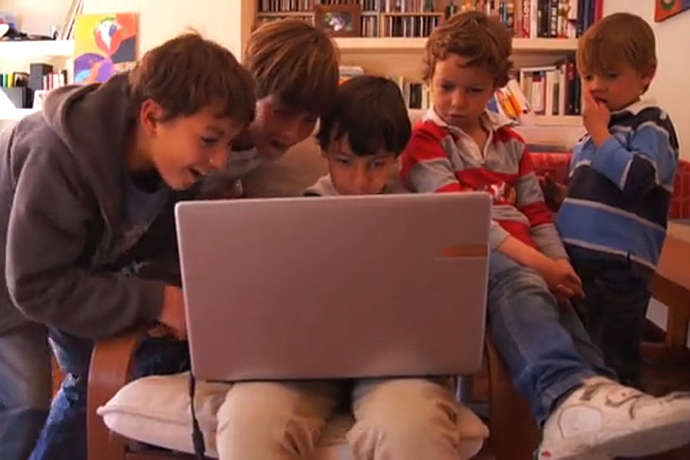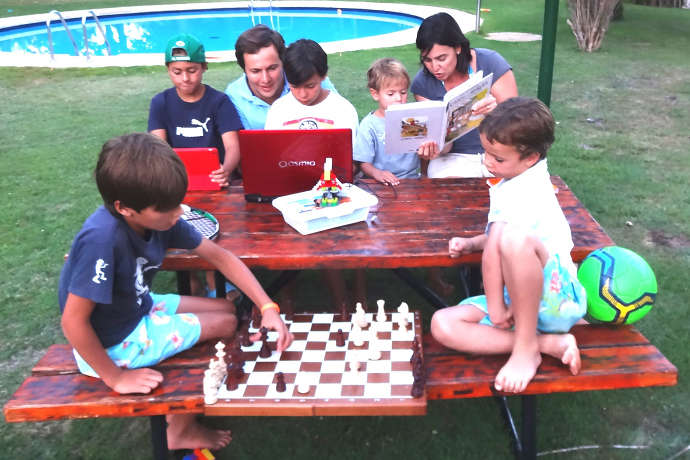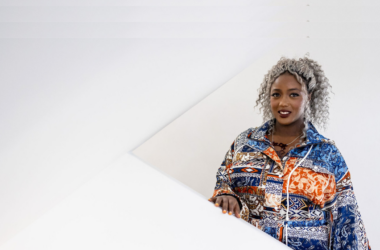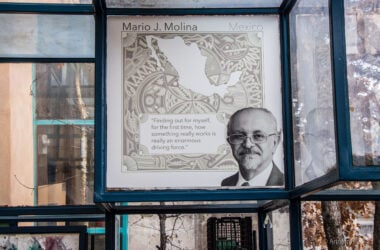I first noticed Luis when he posted this video on his Twitter feed with his five sons:
Creative Thinkers from Luis Carbajosa on Vimeo.
As one of seven children, I appreciate the noisy happy chaos of a large family. Except we had four girls and three boys. Luis and his wife have five boys. Anyone with boys knows how rowdy boys can be at times. But the video also made me wonder: how you keep so many kids active and interested in life, not only technology?
Luis is a Civil Engineer in Spain who is transitioning to a career in business and technology. His wife Eva is an architect who uses AutoCAD (computer aided design) software all day. Their boys are 12, 10, 9, 7 and 5 years old. Luis describes their experiences with raising kids with technology.
Tim: How do you keep 5 boys happy, amused, and non-destructive?
Luis: Our children live in large part of the relationship that my wife and I have with each other. Caring for my relationship with my wife also takes care of them. Also, we are not alone in raising up and educating them. Our home is always open to our friends. We continuously invite people home from school, work, family"¦.. So our children are used to seeing new faces all the time. Also we are certain that our children are a gift to us.
Tim: What have you tried as to family technology? What technology has worked, kept their attention and helped them learn?
Above all Scratch. Our older son already creates very funny games with Scratch, so his brothers can also play with them. We also create funny keyboards together with Makey Makey, and constructions with LEGO WeDo + Scratch. That way children learn that they can not only use technology, but can also be creators. They use a Spanish web platform called Smartick, which has adapted the Kumon method, to help them with their maths homework.
Tim: What have they learned about technology? For example, do they see the larger social issues or their experience is more personal?
Luis: I strive to spread the idea that programming and technology do not have to be something that one does only locked up in his room. That it has to do with play, family and do homework in a different way. And above all it has to do with the hope for our children to develop their creativity…to the extend of influencing people living thousands of miles away.
Tim: How each of your kids have responded to toys, technology, play?
Luis: The little ones love to play games like Angry Birds and Plants vs. Zombies. Ignacio, who is 10 years old, loves Minecraft, which develops his creativity and imagination. The oldest is beginning to use AppInventor. With 12 years, he has already ask us to buy him an smartphone. The other day I told him: If you develop an application for mobiles, I´ll buy you one. Great!!, he said. But what can I do? I know, I’m going to design an app to help Mom do shopping. That’s great! I told him. And if you strive and do it well, you can upload it to Google Play, price it, and entice the parents of your friends to buy it. In that way, you can help buy the smartphone with the money you earn.
Of course, there also is a time and schedule for all. And we don't allow them to remain in front of a screen for too long.
Tim: Where does your wife fit into the picture? Does she actively play with your kids and technology?
Luis: My wife is an architect, and she uses AutoCAD every day. She loves to read with them. She also loves to teach them to cook and is an active searcher of new recipes on Pinterest. But above all she enjoys walking with them up and down the mountain.
Tim: How was your recent experience at the Scratch Conference this summer at MIT in Boston?
Luis: I met many interesting people from around the world. People from the Instituto Thomas Jefferson in Mexico, some researchers from Austria who developed Pocket Code which allows kids to program directly on their smartphones, very similar to Scrach. I also met the founders of the Hopscotch application. And I met August Muench, an astrophysicist at the Harvard-Smithsonian Center for Astrophysics who uses Scratch to model real astronomy data. It’s called Laboratory for the Study of Exoplanets. I also met people from Seville in Boston, people who have developed a website called Dr. Scratch. It automatically analyzes Scratch projects.
I also was in a Makey Makey workshop and it was so fun! I’m thinking about using Makey Makey with Scratch with kids. We made some projects and experiences to introduce Makey Makey in elementary school science classes, creating a physical interface to our Scratch projects using bananas, Play-Doh, aluminum foil, and every day objects.
I also discovered and love the Family Creative Learning Guide Ricarose Roque, from the MIT Media Lab’s Lifelong Kindergarten Group, which introduces families to creative learning through Scratch and Makey-Makey. I also learned about the Computing Curriculum, published by Karen Brennan from Harvard, which uses Scratch. We also saw the future Scratch interface for iPad. I also learned about Pencil Code, a collaborative programming site for drawing art, playing music, and creating games.
Tim: What was the one experience you enjoyed most at the conference?
Luis: The thing I especially enjoyed most was Snap, a re-implementation of Scratch with first-class blocks and first-class lists, aimed primarily at teaching computer science to high school and college students.
I also met some researchers from l'Università degli Studi di Cagliari, Italy, who has developed a website called BloP that enables the development of expanded blocks languages and (unlike well-known Scratch mods like BYOB and Snap!) allows for hiding setup scripts and locking vital features to create a safer environment for experimentation. When students learn basics about programming with Scratch, it can be difficult for them to move to a standard, full-featured language. One approach that can help the transition is to create an expanded blocks language with more of the features of a standard programming language.
Tim: Tell me about your work, what you enjoy as a person, as a family.
Luis: I am a Civil Engineer. I used to work in a construction company and I’ve managed some of the most important civil constructions in the last years in Spain with the Pritzker Architecture Prize Rafael Moneo, like the extension of the Prado Museum and the enlargement of the Atocha Train Station in Madrid.
In October 2013, due to the crisis of the Spanish construction sector, I decided to study an MBA and start developing a web platform to teach kids in Spain. I also participate in the Action English theatre group to teach Theatre in English for Managers and Business Schools. In September I will start teach programming in an American School in Madrid.
I love to read and I love classic movies and my eldest already accompanies me when I watch a Charles Chaplin movie, or some other classic Hollywood film. I love to play Soccer with the other ones.

Learn More
Luis Carbajosa Perez
https://twitter.com/LuisCarbajosaP
http://vimeo.com/user25178593
Scratch MIT 2014
Twitter feed with stories, as well as video links to some key presentations.
https://twitter.com/hashtag/ScratchMIT2014?src=hash
http://scratch.mit.edu/conference
Instituto Thomas Jefferson
http://home.itj.edu.mx/?page_id=180
Pocket Code
Click the Pocket Code App link.
http://www.catrobat.org
Hopscotch
Laboratory for the Study of Exoplanets
Join the search for life outside our solar system.
https://www.cfa.harvard.edu/smgphp/otherworlds/ExoLab/
Dr. Scratch
http://drscratch.programamos.es/
Family Creative Learning
http://family.media.mit.edu/
http://family.media.mit.edu/guide/
Creative Computing
http://scratched.gse.harvard.edu/guide/
Pencil Code
http://pencilcode.net
https://twitter.com/pencilcoder
http://david.pencilcode.net/edit/example/tictactoe
Snap
http://snap.berkeley.edu
http://bjc.berkeley.edu
BloP
http://www.blocklanguages.org/
Scratch
http://scratch.mit.edu/
http://scratch.mit.edu/discuss/
http://scratched.media.mit.edu/
http://scratch.mit.edu/educators/
http://scratch.mit.edu/parents/
http://www.edutopia.org/kindergarten-creativity-collaboration-lifelong-learning
Minecraft
https://minecraft.net
http://minecraftedu.com/
https://kidscodecs.com/raspberry-pi-projects/
https://arghbox.wordpress.com/2013/06/13/programming-minecraft-pi-with-python-early-draft/
http://arghbox.files.wordpress.com/2013/06/minecraftbook.pdf
http://www.raspberrypi.org/learning-python-using-codecademy-and-raspberry-pi-minecraft-a-resource-of-great-note/
http://arghbox.wordpress.com/
http://www.stuffaboutcode.com/
http://www.scarabcoder.com/
http://blog.whaleygeek.co.uk/category/raspberry-pi/
http://mcpipy.wordpress.com/
AppInventor
http://appinventor.mit.edu/explore/
Makey Makey
Lego WeDo
https://education.lego.com/en-us/lesi/elementary/wedo
http://education.lego.com/en-us/preschool-and-school/lower-primary/7plus-education-wedo










